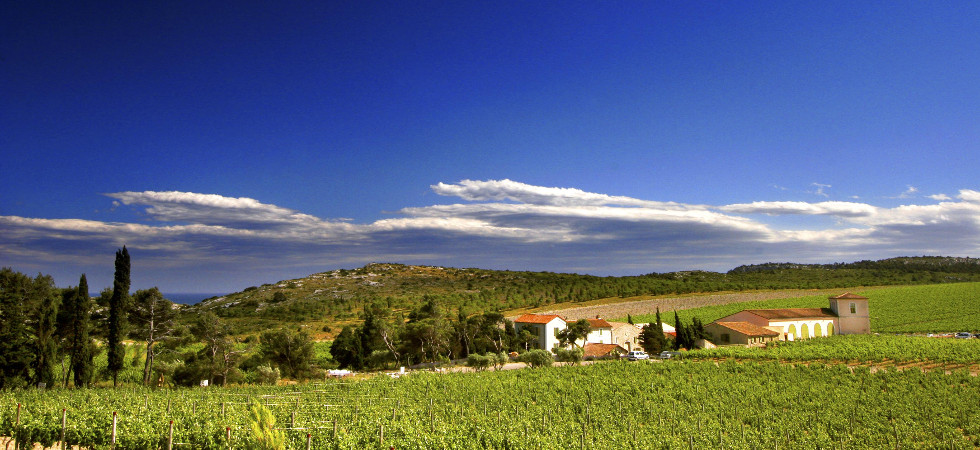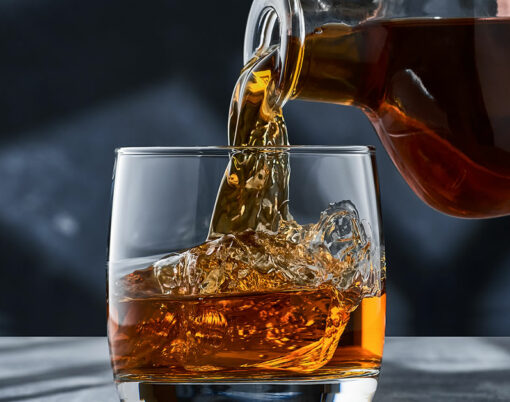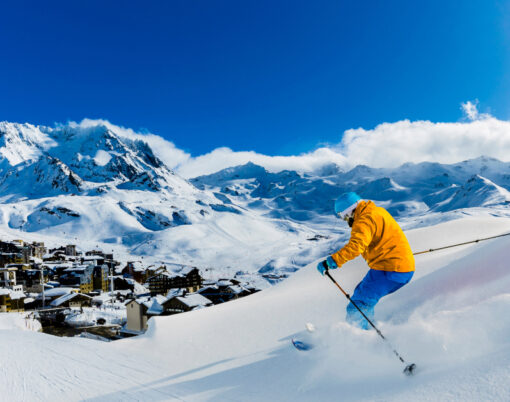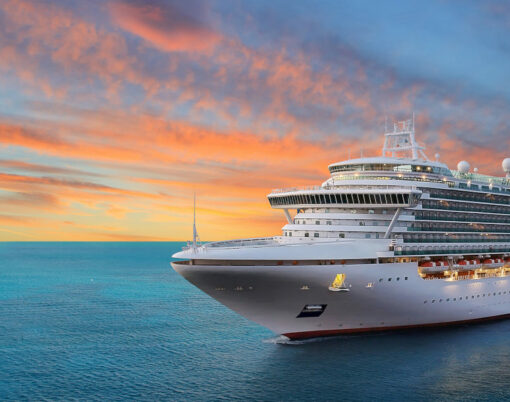It is well known that the French take their wine and their food very seriously indeed. I travelled in a small group, courtesy of the Conseil Interprofessionel des Vins du Languedoc (CIVL), to the South of France to discover how the locals live the Mediterranean life.
The Languedoc is situated between the Mediterranean and the Pyrenees, from the Spanish border to Nimes. The region offers a cornucopia of cultural, historical and heritage attractions and, of course, great food and wine. We stayed at a wine chateau, took a boat out to an oyster farm, and another on the Canal du Midi, spent a fun afternoon pairing wine and food with an expert in her home, and enjoyed an idyllic picnic in the grounds of a former chapel.
The Mediterranean life
We stayed at the Château l’Hospitalet situated at Narbonne at the centre of the protected massif, La Clape. The owner, Gérard Bertrand, was captain of the Stade Francais rugby team until he retired in 1994, following the accidental death of his father he took over the family estate. The renowned winemaker owns 15 wines estates.
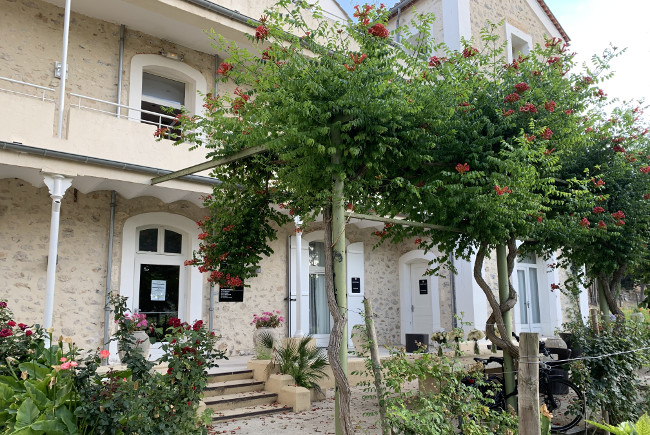
Eight of these use the biodynamic method based on the influences of the moon, planets and constellations and without chemicals. The grapes are grown using natural materials including oak bark, nettles, and animal horn dung. Bertrand aims to have all his plots converted to this method by 2023.
Accommodation
The Château hotel merges into the lush and peaceful countryside. The 38 rooms and suites are comfortably furnished using natural materials. My bathroom was compact but manageable. The sleeping area was spacious with a living room area on a small mezzanine floor above.
There is a good sized outdoor pool for guests surrounded by shady trees. This was especially welcome as we visited during the recent heat wave, with temperatures in the high 30 degrees.
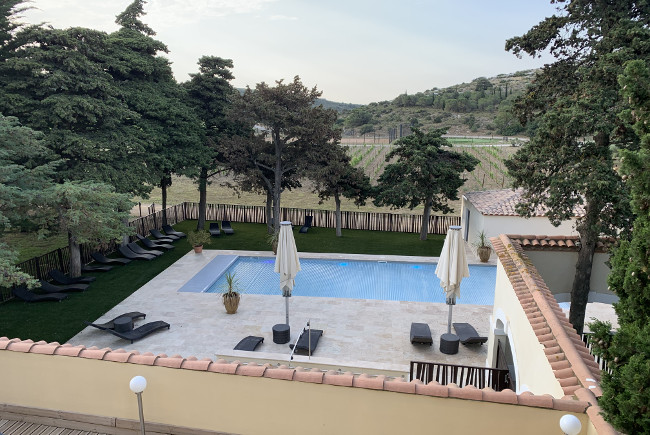
The Restaurant La Vivre under young Chef Laurent Chabert is open in the evenings and features a walk-in glass fronted wine cellar, offering diners a wide choice of wines to try. The fine dining menu features seasonal regional produce. For instance, our starter was a simple salad of fresh sun-ripened marmande-style tomatoes with basil, and a dressing made with the Chateau’s own dark, fruity olive oil. Sadly, this is not for sale but produced only for Chef’s kitchen.
Accompanying wines included Clos de Temple 2018 which is perfectly balanced, elegant and fresh, and made from a blend of very old Cinsault, Grenache Noir ad Syrah. Rosè wines of this region are not overly sweet but are crisp and intense, and a pale blush in colour.
“Rose wines are the most difficult to make,” said Christine Molines, Head of Marketing at the CIVL as we sipped. “It is a very fragile wine, with just a matter of minutes’ difference during the pressing process to achieve the desired colour and flavour.” New temperature controls are resulting in better quality which is clearly evident in the sophisticated Languedoc wines.
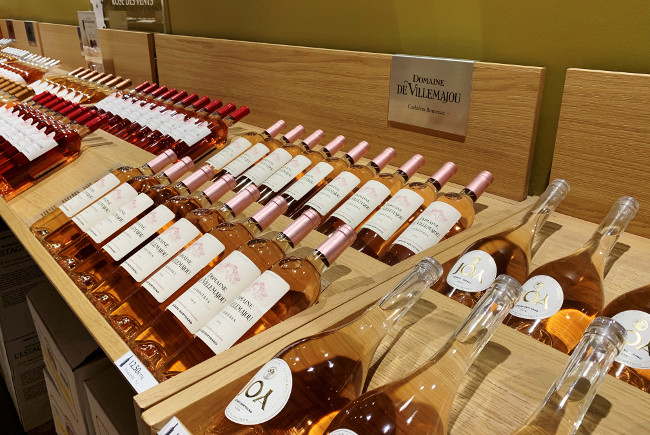
It makes sense for vineyards to have bee hives on the land to aid pollination, and preserve the bee population. Consequently, the buffet breakfast included a whole honeycomb of golden honey, perfect for drizzling over fresh creamy yogurt with sun-ripened apricots.
The Château offers guided tours which include a trail of the vineyards to explore the flora and fauna and a visit to the barrel cellar – with an excellent introduction to the biodynamic approach. The tour ends at the cellar door with the opportunity to taste the wines.
There is also a Chateau gallery which stages small exhibitions and in summer there is a Jazz Festival in this stunning location. Wine, good food, music and art are all part of the Mediterranean way of life here, and throughout the Languedoc region.
Citroen 2CV tour
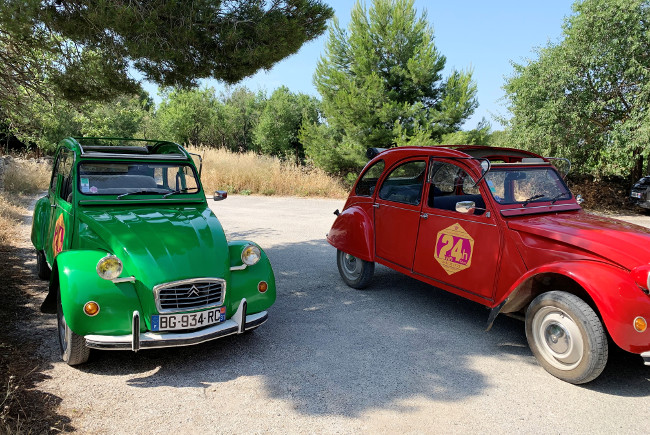
We spent an enjoyable morning exploring the Fitou appellation in two colourful vintage Citroen 2CVs. The 2CV is a French national icon and we drew some appreciative attention. A tour of the countryside stopped for elevenses of snacks and herbal tea from a flask, under some shady trees on a hill. The stunning view was of La Franqui sandy beach, a hidden gem and practically deserted.
Our guide, Isabelle Castro gave us a round-up of the local wine-making industry of around ten artisan wine makers in the area. Small wine makers are supported by a mobile bottling service that travels from village to village.
After collecting prepared food and wine from a local restaurant we picnicked in the garden of the former 19th century chapel of the Famille Marieville. The small building was previously part of a large wine estate. It is now privately owned by neighbours, friends of Isabelle who wanted to preserve the land from development. The tiny chapel has been reinvented as a private gallery to display work by local artists.
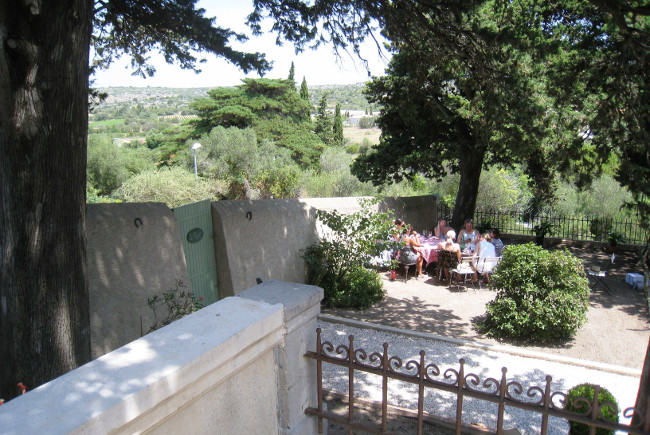
Each dish was beautifully presented in individual portions. We ate a soft creamy salted cod dish, Brandade de Morue, decorated with tiny fronds of dill and served with carrot puree. Fresh salads of tabbouleh with herbs, beets and carrot râpées paired well with fresh bread and four different local cheeses.
The romantic setting was high up and overlooked the breathtaking landscape. It felt like we were on a Famous Five adventure. The luscious food was washed down with, not lashings of ginger beer, but fruity Fitou wines. Flasks of hot coffee and mini chocolate choux pastries completed the meal. It was one of those wonderful snapshots in time, of a sunny day with clear blue skies and the sound of cicadas chirping, that remain with you.
Canal du Midi

Summer temperatures in the South of France are high although there is always a good breeze. To cool down we boarded a boat along the pretty waters of the Canal du Midi from Beziers. It was very peaceful with the sun reflecting off the water and the breeze rustling the leaves in the trees lining the water’s edge.
It was rather romantic but this was no ordinary boat trip. We were fortunate to have a little wine tasting on board. This time the accompanying snacks included tiny pastry ‘chimney stacks’ filled with minced lamb, a specialty of the region. Special boat trips on the Canal, such as Le Grand Bief Meal Cruise and a Musical Dinner Evening Cruise, are bookable online.
Wine and food pairing
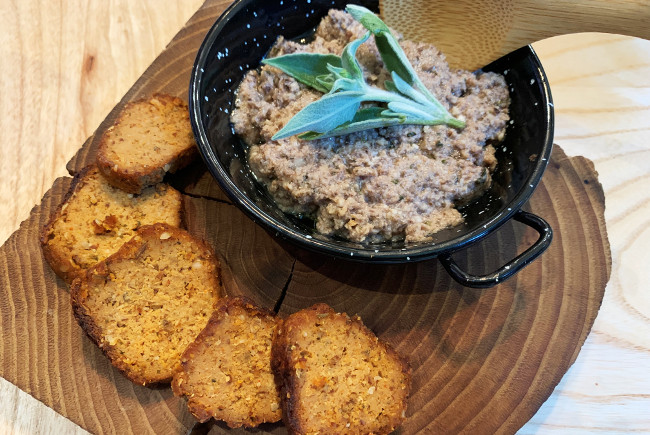
Another day, another marvellous lunch. We spent an afternoon with Emma Kershaw at a workshop in her beautiful home, La Maison du Rire, a converted old winery in the Corbières region. Previously a teacher at WSET Diploma level, her mouth-watering homemade tapas dishes throughout the workshop were accompanied by a range of personally recommended regional wines.
We tucked into a banquet of seasonal dishes: fresh courgette carpaccio made with garlic and fresh green herbs; chilled courgette and goat’s cheese velouté in little pots; radish leaf pesto (amazingly good); saucisson and chicken liver pate (there was also a spicy vegetarian saucisson which looked identical); and more, including an almond cake with fresh apricots. Emma cooks with produce from local markets or her own garden. The long lazy afternoon was spent simply tasting, little mouthfuls of food and sips of wine, and chatting.
How do oysters grow?
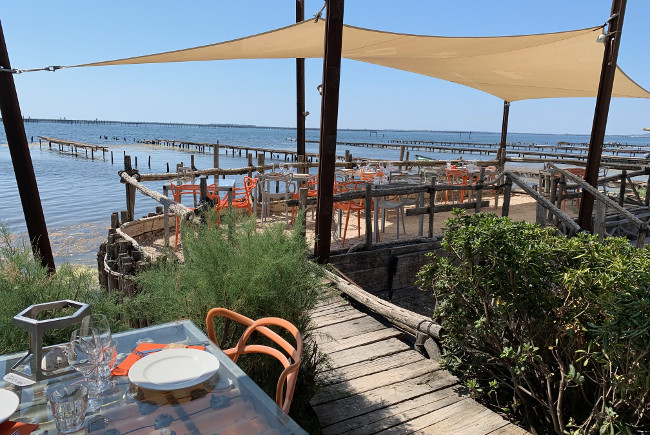
On our last day we visited an oyster farm at Étang de Thau (Mediterranean Sea) situated between Béziers and Montpellier. A little boat took us out into the Lagune de Thau a where the tiny oysters in the ‘nursery’ begin life in pods strung on a vertical line. We sailed on over the sparkling blue waters to where the larger oysters are almost ready to harvest.
The owner at Tarbouriech le Maison has developed a unique system powered by solar energy to recreate the tidal movement absent in the Mediterranean, which helps to produce the size and quality of oyster desired by chefs and diners.
The oysters had a mild salt iodine flavor with a little sweetness. The waterside ‘tasting counter’ (a restaurant although it cannot be called one) serves just four dishes: an olive tapenade, Mussels Brasucade (cooked outdoors over an open fire); Tielles – a regional spicy tomato octopus pie; and oysters.
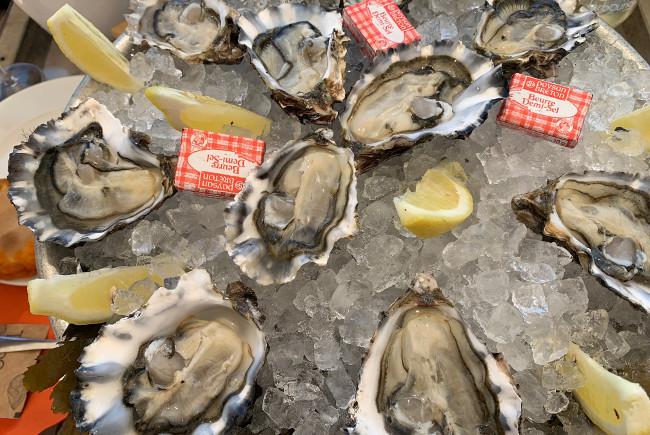
We drank the regional Picpoul de Pinet wine, lightly chilled, as we relaxed on the decking under big canvas ‘sails’ overlooking the beautiful lagune. There are very few places where you can eat food which has been harvested just hours previously, and from such clear, sparkling waters.
It was another significant moment in a trip made up of special moments. A step back in time to a slower and more enjoyable day-to-day pace. In the Languedoc time is taken to enjoy food and wine, not just the eating but the growing and making. It is a community with a passion and a commitment to the land. A way of life.
FACTBOX
We flew from Gatwick to Toulouse in just 90 minutes, returning from Montpelier, courtesy of the Conseil Interprofessionel des Vins du Languedoc.
Chateau l’Hospitalet. Room only from 141 Euros for a Classic Room. Guided tours last 1 hour 30 minutes and days and times vary according to the time of year. Adult 13 Euros, child 7 Euros, under 10 years free. Master Classes and Blending Workshops. Prices on demand.
La Maison du Rire wine and food pairing workshops with Emma Kershaw.
Bateau le Colombiers offer boat trips on the Canal du Midi.
Wines courtesy Bruno Andreu Wines.
Wine Tourism 24h Vin Tour in Vintage Citroen 2Cvs book online
Tarbouriech La Maison
Image credits – The main image is courtesy of Gilles Deschamps and all others courtesy of Irene Caswell












